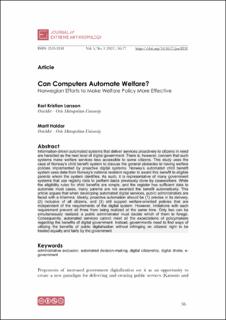| dc.contributor.author | Larsson, Karl Kristian | |
| dc.contributor.author | Haldar, Marit | |
| dc.coverage.spatial | Norway | en_US |
| dc.date.accessioned | 2021-10-27T14:15:33Z | |
| dc.date.available | 2021-10-27T14:15:33Z | |
| dc.date.created | 2021-09-20T13:14:23Z | |
| dc.date.issued | 2021-06-20 | |
| dc.identifier.citation | Journal of Extreme Anthropology. 2021, 5 (1), 56-77. | en_US |
| dc.identifier.issn | 2535-3241 | |
| dc.identifier.uri | https://hdl.handle.net/11250/2826065 | |
| dc.description.abstract | Information-driven automated systems that deliver services proactively to citizens in need are heralded as the next level of digital government. There is, however, concern that such systems make welfare services less accessible to some citizens. This study uses the case of Norway’s child benefit system to discuss the general obstacles to having welfare policies implemented by proactive digital systems. Norway’s automated child benefit system uses data from Norway’s national resident register to award this benefit to eligible parents whom the system identifies. As such, it is representative of many government systems that use registry data to perform tasks previously done by caseworkers. While the eligibility rules for child benefits are simple, and the register has sufficient data to automate most cases, many parents are not awarded the benefit automatically. This article argues that when developing automated digital services, public administrators are faced with a trilemma. Ideally, proactive automation should be (1) precise in its delivery, (2) inclusive of all citizens, and (3) still support welfare-oriented policies that are independent of the requirements of the digital system. However, limitations with each requirement prevent all three from being realized at the same time. Only two can be simultaneously realized: a public administrator must decide which of them to forego. Consequently, automated services cannot meet all the expectations of policymakers regarding the benefits of digital government. Instead, governments need to find ways of utilizing the benefits of public digitalisation without infringing on citizens’ right to be treated equally and fairly by the government. | en_US |
| dc.description.sponsorship | This research for this paper was co-financed by the Norwegian Labour and Welfare Administration (NAV) and the Research Council of Norway [grant number 289920] as part of the Public Sector Ph.D. scheme. | en_US |
| dc.language.iso | eng | en_US |
| dc.publisher | Universitetet i Oslo | en_US |
| dc.relation.ispartofseries | Journal of Extreme Anthropology;Vol. 5 No. 1 (2021): Algorithmic Governance: Fantasies of Social Control | |
| dc.rights | Attribution-NonCommercial-NoDerivatives 4.0 Internasjonal | * |
| dc.rights.uri | http://creativecommons.org/licenses/by-nc-nd/4.0/deed.no | * |
| dc.subject | Administrative exclusions | en_US |
| dc.subject | Automated decision-making | en_US |
| dc.subject | Digital citizenships | en_US |
| dc.subject | Digital divides | en_US |
| dc.subject | E-governments | en_US |
| dc.title | Can Computers Automate Welfare? Norwegian Efforts to Make Welfare Policy More Effective | en_US |
| dc.type | Peer reviewed | en_US |
| dc.type | Journal article | en_US |
| dc.description.version | publishedVersion | en_US |
| dc.rights.holder | Copyright (c) 2021 Marit Haldar, Karl Kristian Larsson | en_US |
| cristin.ispublished | true | |
| cristin.fulltext | original | |
| cristin.qualitycode | 1 | |
| dc.identifier.doi | https://doi.org/10.5617/jea.8231 | |
| dc.identifier.cristin | 1936019 | |
| dc.source.journal | Journal of Extreme Anthropology | en_US |
| dc.source.volume | 5 | en_US |
| dc.source.issue | 1 | en_US |
| dc.source.pagenumber | 56-77 | en_US |
| dc.relation.project | Norges forskningsråd: 289920 | en_US |

